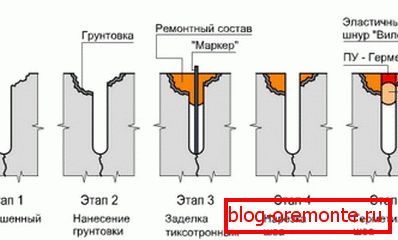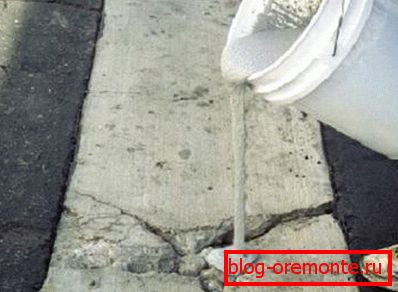What and how is used the repair composition for concrete
Concrete is a building material that is different from others by durability, reliability and can serve for a long time. But, it is possible that it is subject to destructive external influence. After a while, cracks and irregularities can appear on it, so the article will look at how to get rid of such damage with the help of repair mixtures and compounds.

What it is
The reducing composition consists of:
- cement;
- sand;
- fillers;
- all sorts of additives that endow the solution with the qualities necessary for its strength.
In dry form, repair compositions for concrete can be applied immediately, for this they add water and mix thoroughly.
With the help of such solutions eliminate the drawbacks on structures made of concrete, in particular:
- the floor;
- the stairs;
- the bridge;
- wall;
- the road.

Also compositions for repair in a dry form, as a rule, are used for the following purposes:
- repair work of the main structures that perform the function of bearing: concrete beams, floor slabs, columns and others;
- the implementation of repair work pavement (runways for aircraft, parking lots), concrete floors in industrial enterprises, warehouses;
- as protection of surfaces from concrete against corrosion.

To date, there is a diverse selection of concrete repair compositions, ranging from various manufacturers and ending with the properties of funds. The price of mixtures also has a wide range.
The compositions intended for elimination of defects are divided into two main types:
- molded, which are used for horizontal surfaces;
- thixotropic - for vertically located planes.
Tip: to increase the reinforcement performance, you must add fiberglass as part of repair tools.
How to choose a mixture
When choosing, you need to consider several indicators, namely:
- what damage;
- what is the surface defect;
- conditions of its operation.
| How to strengthen the concrete surface? | Often, surfaces made of concrete, which are subjected to heavy loads, have insufficient strength. Monolithic structures can be distinguished, such as a concrete screed and floor slabs. They need to be strengthened with a deep penetration primer. |
| How to level a concrete surface? | Irregularities are the most common defect in concrete structures. In this case, you can also use a deep penetrating primer. Thixotropic dry mix is excellent for a vertical surface, as it is evenly applied to the plane, it does not blur and sets well. Also this composition:
|
During repair work on particularly important concrete areas, the use of reinforced fiberglass is most appropriate. In addition, there are special tools designed to carry out repairs in a short time, which quickly freeze.

Tip: apply each layer with a thickness of no more than 35 mm. A, If the reinforcement in concrete structures is bare, it should be treated with an anticorrosion primer.
To level a horizontal surface, apply dry molding repair solution for concrete. It has a liquid consistency compared to thixotropic.
Casting composition, you just need to pour on the concrete surface. At the same time one layer can be 100 mm thick. The composition has minimal shrinkage, it firmly covers the surface and instantly seizes.

When repairing cracks in concrete, which often occur on its surface, use the same mixture that was used to align the plane. Choosing them, consider the conditions for further operation of the structure.
In the manufacture of such a mixture in the composition may be different components that give the tool certain characteristics, for example:
- resistance to frost;
- hydrophobicity;
- reducing the hardening time of the solution.
How to level the floor surface
Align the horizontal surface with your own hands. However, the work will require considerable effort, certain knowledge and methods, but, adhering to the technology, you can independently achieve the necessary quality. To level the floor, you need a cement-sand screed.
The following is the instruction to work with it:
- In the first stage, clean the floor from dust and dirt.. Remove the old coating, primer the surface for a more even distribution of the solution.
- Determine the highest point from which the leveling of the floor will begin.
- Install beacons for which metal corners, pipes or profiles are suitable. Put them so that they are located on the same level.

Tip: it's better to do this with a laser level.
- Proceed to pouring screed. At the same time its layer should be up to 40 mm thick. The solution, which was previously mixed in a metal or plastic container, pour onto the surface, then continue the alignment of the fill using the rule.
After pouring, allow the screed to dry well for a couple of weeks. The next day after the execution, if the solution managed to gain some hardness, remove the beacons, and fill the seams with grout.
Tip: during drying, cover the tie with polyethylene film. From time to time, moisten the surface with water to avoid cracking and give strength to the screed.
It is possible to carry out repair of horizontal surfaces from concrete by means of the self-leveled means. It is used in the event that on the surface there are small defects or irregularities up to 3 mm. The result is an absolutely smooth plane.
How to remove potholes
It happens that potholes are formed on the surface of concrete.
It is recommended to clean them in stages.
- First make a cut along the perimeter of the defect, its depth should be up to 20 mm. Use for this purpose grinder with a diamond disc.
- Remove excess concrete with a chisel or perforator.
- Remove residual dirt and dust. To better remove all rubbish, you can use sandblaster equipment or a vacuum cleaner.
- Apply an epoxy primer to a clean surface that helps to hold the concrete in place.

- Fill the pothole with a special mixture, which may be repair compounds for reinforced concrete.
- Remove excess mixture from the surface, level it with a rail or rule.
The patch must be sustained until it is completely dry. In this case, the tool will be strong enough. The last stage - polishing the patch.
Conclusion
For repairs, it is better to use special mixes in dry form instead of standard concrete solution. Such repair tools have certain properties that will provide the coating with adequate strength. The video in this article will help you find additional information on this topic.